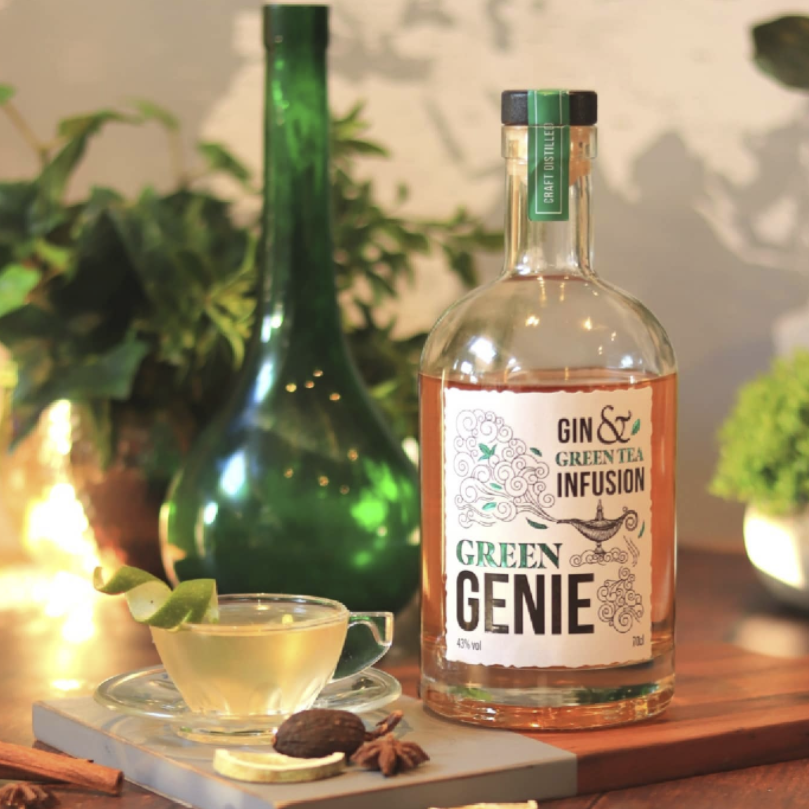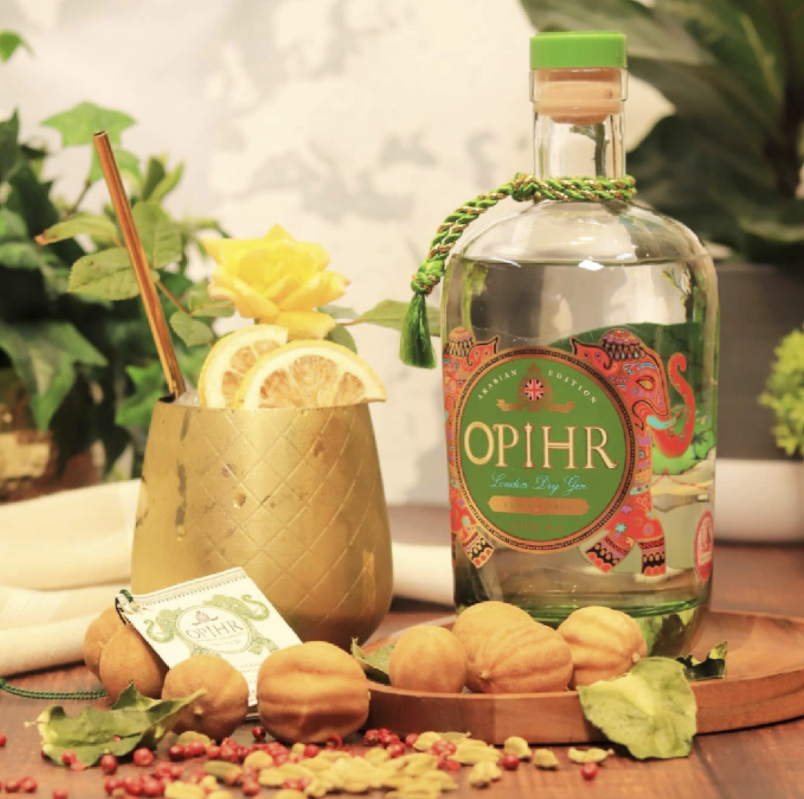MIDDLE EAST
DAY 68 ARABIAN NIGHTS
ARABIAN NIGHTS
The secret is out - there is a genie in the bottle and it's green (tea)! #ginadaymay
For centuries spices were transported from the east to the west along the Ancient Overland Silk or Spice Routes, as well as Maritime Silk Roads. It's therefore appropriate that I include a reference to these historical routes in this virtual tour, as spices like cinnamon, cassia, cardamom, ginger, nutmeg, star anise and even tea travelled this route and feature in so many of my favourite gins.
Green Genie Gin was inspired by Steve Scutt's travels to China and the Middle East and contains a unique blend of 12 botanicals, including ginseng, coriander seed, citrus, juniper and of course green tea. Steve has travelled extensively in the area and his appreciation for green tea and it's benefits developed during time spent in China and Japan where he had the idea of using it in food and drink applications.
As co-founder of Innovative Functional Foods, Steve was curious to see if they could use green tea in cold drinks and then started experimenting with it in spirits. As a result, two magical products were created - Green Genie Gin and Green Russian Vodka.
Green Genie Gin's inspiration was Bedouin Tales of the Djinn or Jinn - anglicised as Genie. These tales are not all Disney, with djinns being magical begins or shapeshifters, some hostile, dark and demonic, but others friendly. It's said they are attracted to the sweet smell of jasmine, hence only elders use this fragrance, as they could do unseemly things to unmarried girls. They are good or bad depending on faiths but have deep roots in Arab culture.
The gin is citrus forward and infused with green tea botanicals. It's distilled from 100% molasses spirit. There is a delicate sweet and spicy balance, it's quite smooth and it has a dry finish most likely from the tea. I've tried it in a few G&Ts - recommended with classic tonic and grapefruit, but for this serve, I've gone with a little magic, using Supasawa to replace lime in a Green Tea Gimlet.
Genie in a teacup!
45ml Green Genie Gin
15ml Sugar Syrup
25ml Supasawa
IFF have partnered with Black Bridge Distillery, who are based on the Luton Hoo Estate near Harpenden, to create these special products. They are available through Amazon, but also newly stocked at larger Tesco stores in Hertfordshire, Bedfordshire and online.
DAY 69 THE SILK ROAD
FRANKINCENSE & THE SILK ROAD
Ten days till #worldginday and the end of this 80 day tour ( I still can't believe I've done every day so far!) and I'm slowly bringing myself back to Blighty by featuring yet another local gin!
Sacred Microdistillery, founded by Ian Hart in 2009, is based in Highgate London and they make a range of spirits through vacuum distillation. Their Sacred Gin contains 12 botanicals, which include cardamom, nutmeg and frankincense. This set the tone for all their expressions and frankincense - Boswellia sacra, sourced from the Sultan of Oman - is what gave the brand its name.
Their Single Botanical range consists of 90% distillate of the single botanical blended with 10% of Sacred gin. Whilst cardamom and mandalas are more likely to be found a little more east and I've chosen this bottle today for a G&T because I love cardamom, my focus is more on the Frankincense and the role it plays in Sacred Gin and indeed where it's sourced.
Frankincense is an aromatic resin which is used in incense and perfumes. It has been traded on the Arabian Peninsula for many centuries and from the Horn of Africa during the Silk Road era. The trees are native to Southern Arabia and it's the resin that is harvested, as when it hardens, it turns into incense, still used today by the Catholic Church. The trees are only tapped a couple of times a year, as any more reduces the seeds they produce, which is not ideal, given the boswellia sacra is under threat due to over-harvesting and clearing of land for agriculture. Most of the world's supply comes from Somalia, Eritrea and Yemen, but conflict in recent years in these countries has affected production. Despite the inhospitable terrain, the Boswellia Sacra tree thrives in Oman, which produces the world's finest and most expensive frankincense. The trees, ancient caravan routes and ports together form part of Oman's Uniesco-inscribed Land of Frankincense World Heritage Site.
The frankincense is described as woody, peppery, spicy, resinous and citrussy - very similar to juniper - and it's the terpenes, alpha-pinene and limonene compounds which transfer over in the distillation process. It's chewed like gum to freshen breath and it has a long list of medicinal uses - even used in embalming. It's believed the whiter the resin the higher the value, but in fact different soils and microclimates affect the colour, so you find it ranging from white to cream, brown or even black.
Other countries produce frankincense as well but not from Boswellia sacra and this makes me think of mastic from Greece, which is also a similar product and used in gin too.
DAY 70 PERSIA AND THE SILK ROUTE
LOOMI (PERSIAN BLACK LEMONS)
Opihr takes it's name from a mysterious location along the Silk Route, which was famed for its wealth of gold, silver and spices during the reign of King Solomon. One of the most likely regions identified in the many theories of where it may be is India, but the list includes Sri Lanka, Philippines, Zimbabwe, The Red Sea, Peru and even the Solomon Islands, so unfortunately the mystery remains. The products said to have been received from Opihr include gold, sandalwood, peacocks, monkeys and ivory, so you can make your own deductions!
Spices of the Orient is one of the first gins I had in my collection and I had forgotten just how much I enjoyed it until recently. As the range from Quintessential Brands and G&J Distillers is inspired by the Ancient Silk Route, I thought I would feature one of their Regional Edition Gins - Arabian Edition, which includes citrus, spice, Persian black lemons and timut peppers. This gin bursts of Middle Eastern flavours - bright and earthy with a peppery middle and fresh citrussy finish, perhaps a hint of camphor there too.
Black lemons play a central part in Persian cooking thanks to their sweet citrus flavour and the lack of bitters that other lemons bring. They are actually dried limes and have a fragrant earthy, smoky and slightly fermented taste. They bring acidity to a dish and are often used in the Middle East in chutneys, soups and stews. I played about with this thinking surely I could make a spiked Black Lime tea using the gin, and it was actually quite good - gin, hot water (just off the boil), a bit of honey and a generous squeeze of lime. I also threw in some kaffir lime leaves for interest!
However, I think this gin is best in a G&T but I've added 25ml Supasawa to 50ml Opihr Arabian Edition and a premium tonic, just to lift it. The Supasawa is zingy and balances out the earthy rich spices, so they come through at the end of each sip, but that freshness stays. Just what you need to be sipping for Desert Sundowners!
My Loomi are not quite black! I was sure I chose black limes, but anyway, they are dried limes too....just not black! They smell divine - fermented and lemony....almost like a campfire as they are quite smokey smelling too! I may throw one in my next G&T and see what that's like!
DAY 71 MIDDLE EAST INSPIRED
INSPIRED BY MIDDLE EASTERN SPICES
I'm sure you are all familiar with Cotswolds cloudy gin, but they do have a range of other gins, which I've been fortunate to try when visiting their distillery. One of my other favourites is their Ginger gin, but this one pipped it to the post and come home with me.
Baharat is a spice blend commonly used in Middle Eastern cooking and is the plural Arabic word for spice (bahar). The seasoning likely developed due to the spices becoming available in the Middle East due to the Ancient Spice Route, and over the centuries of this trade, Arabian cooks developed a familiarity with them and they became part of this region's food culture. There are many different blends with different regions across North Africa and the Mediterranean region accenting on specific herbs or spices. Turkish Baharat includes mint and often fennel; Tunisian rose petals and cinnamon. Whilst they are similar to other blends like garam masala and za'atar, each of these have their own cultural differences and spices, making the blends unique to each region.
Baharat has warm, earthy notes, and is a combination of both sweet and smoky without any spiciness. While the taste is not overpowering, it is very aromatic, just like this gin.
Cotswolds have blended juniper with coriander, cardamom, chilli, cinnamon, clove, cumin and black pepper - all spices that we know were traded on the Spice Route and make up Baharat seasoning. In addition, they have added a touch of citrus in the form of fresh Jaffa orange peel. It makes the nicest G&T, but can also be served up with ginger ale.
I've gone with something a little different - a Spiced Espresso Martini, with a side of Persian Almond Nougat. For this I've also used the delicious Coffee Orange Gin from Laura at Lava Spirits.
Baharat Espresso Martini
45ml Baharat Gin
15ml Lava Spirits Coffee & Orange
30ml Espresso Coffee
10ml Sugar syrup
DAY 72 ISRAEL
THE LAND OF MILK & HONEY
Day 72 #virtualworldgintour
A group of entrepreneurs got together in 2012 and hatched a plan to establish the first whisky distillery in Israel and in 2017 they unveiled their first single-malt whisky. They are an urban distillery, located in one of Tel Aviv's trendy neighbourhoods. The hot and sunny climate means their whisky ages quickly and the flavour differs from those aged in cooler climates. This also means the angel's share is higher and at around 11%. They stick to the Scottish rule of aging their whisky for at least 3 years in ex-bourbon and red wine casks and are always looking for interesting casks to experiment with.
Their Levantine Gins start as a single malt to which they add juniper and botanicals which are sourced from Tel Aviv's Levinsky market. Unfortunately the barley grown in Israel is not suitable for making whisky as it lacks the necessary sugars, so they source from the UK. The Oak Aged version is rested for around 6 months in red wine STR (shaved, toasted and recharred) casks and takes on a subtle vanilla flavour.
The distillery is of course kosher, and the barley they use is significant as well. It's one of the two grains (wheat and barley) which are listed in the Hebrew Bible as being special products of the Land of Israel. The other 5 products which make up the Seven Species are fruit - grape, fig, pomegranate, olive and date. Only the first fruits of the Seven Species were allowed as offerings in the Temple of Jerusalem and till today these fruits are common ingredients in Israeli cooking. There is also heavy influence from the Middle East and Mediterranean in the dishes and of course, spices which made their way there via the Spice Route. Za'atar is a spice blend usually made up of oregano, thyme, marjoram, sumac and sesame seeds, but recipes vary between the Middle Eastern countries.
My serve nods to the Seven Species (although I can't guarantee it's kosher!) and is a Pomegranate Negroni (Pom-Groni) garnished with a lightly grilled fig.





